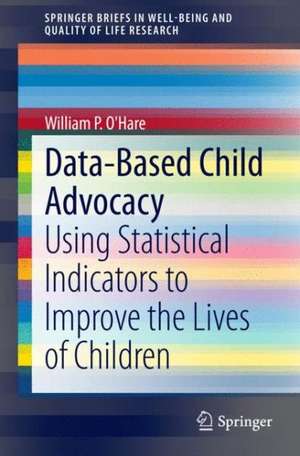Data-Based Child Advocacy: Using Statistical Indicators to Improve the Lives of Children: SpringerBriefs in Well-Being and Quality of Life Research
Autor William P. O'Hareen Limba Engleză Paperback – aug 2014
Din seria SpringerBriefs in Well-Being and Quality of Life Research
- 5%
 Preț: 252.59 lei
Preț: 252.59 lei -
 Preț: 277.91 lei
Preț: 277.91 lei - 5%
 Preț: 324.88 lei
Preț: 324.88 lei - 5%
 Preț: 422.13 lei
Preț: 422.13 lei -
 Preț: 410.01 lei
Preț: 410.01 lei - 5%
 Preț: 326.32 lei
Preț: 326.32 lei -
 Preț: 379.09 lei
Preț: 379.09 lei - 5%
 Preț: 358.48 lei
Preț: 358.48 lei - 5%
 Preț: 322.85 lei
Preț: 322.85 lei -
 Preț: 376.80 lei
Preț: 376.80 lei - 5%
 Preț: 357.23 lei
Preț: 357.23 lei -
 Preț: 410.94 lei
Preț: 410.94 lei - 5%
 Preț: 356.32 lei
Preț: 356.32 lei - 5%
 Preț: 357.61 lei
Preț: 357.61 lei -
 Preț: 377.73 lei
Preț: 377.73 lei -
 Preț: 375.07 lei
Preț: 375.07 lei - 5%
 Preț: 329.66 lei
Preț: 329.66 lei - 5%
 Preț: 356.46 lei
Preț: 356.46 lei -
 Preț: 378.34 lei
Preț: 378.34 lei - 5%
 Preț: 358.48 lei
Preț: 358.48 lei - 5%
 Preț: 358.32 lei
Preț: 358.32 lei -
 Preț: 376.80 lei
Preț: 376.80 lei - 5%
 Preț: 421.92 lei
Preț: 421.92 lei -
 Preț: 379.30 lei
Preț: 379.30 lei -
 Preț: 378.71 lei
Preț: 378.71 lei -
 Preț: 375.45 lei
Preț: 375.45 lei - 5%
 Preț: 358.84 lei
Preț: 358.84 lei -
 Preț: 385.44 lei
Preț: 385.44 lei -
 Preț: 376.04 lei
Preț: 376.04 lei - 5%
 Preț: 364.85 lei
Preț: 364.85 lei -
 Preț: 355.07 lei
Preț: 355.07 lei -
 Preț: 357.86 lei
Preț: 357.86 lei -
 Preț: 411.54 lei
Preț: 411.54 lei - 5%
 Preț: 329.95 lei
Preț: 329.95 lei -
 Preț: 377.95 lei
Preț: 377.95 lei -
 Preț: 478.53 lei
Preț: 478.53 lei - 5%
 Preț: 357.77 lei
Preț: 357.77 lei - 5%
 Preț: 356.67 lei
Preț: 356.67 lei -
 Preț: 410.55 lei
Preț: 410.55 lei - 5%
 Preț: 362.16 lei
Preț: 362.16 lei - 5%
 Preț: 357.23 lei
Preț: 357.23 lei - 5%
 Preț: 357.97 lei
Preț: 357.97 lei - 5%
 Preț: 359.42 lei
Preț: 359.42 lei - 5%
 Preț: 358.84 lei
Preț: 358.84 lei -
 Preț: 442.02 lei
Preț: 442.02 lei -
 Preț: 378.54 lei
Preț: 378.54 lei
Preț: 356.67 lei
Preț vechi: 375.45 lei
-5% Nou
Puncte Express: 535
Preț estimativ în valută:
68.25€ • 71.26$ • 56.36£
68.25€ • 71.26$ • 56.36£
Carte tipărită la comandă
Livrare economică 15-29 aprilie
Preluare comenzi: 021 569.72.76
Specificații
ISBN-13: 9783319078298
ISBN-10: 3319078291
Pagini: 50
Ilustrații: IX, 65 p. 1 illus.
Dimensiuni: 155 x 235 x 10 mm
Greutate: 0.12 kg
Ediția:2014
Editura: Springer International Publishing
Colecția Springer
Seria SpringerBriefs in Well-Being and Quality of Life Research
Locul publicării:Cham, Switzerland
ISBN-10: 3319078291
Pagini: 50
Ilustrații: IX, 65 p. 1 illus.
Dimensiuni: 155 x 235 x 10 mm
Greutate: 0.12 kg
Ediția:2014
Editura: Springer International Publishing
Colecția Springer
Seria SpringerBriefs in Well-Being and Quality of Life Research
Locul publicării:Cham, Switzerland
Public țintă
ResearchCuprins
Introduction.- 1 What is Data-Based Child Advocacy?.- 2 Types of Advocacy Activity Using Child Indicators.- 2.1 Increasing Public Awareness about Child Well-Being.- 2.2 Making Data on Child Well-Being Easily Available.- 2.3 Advocating for More and Better Data on Children.- 2.4 Child Well-being Monitoring.- 2.5 Goal Setting.- 2.6 Evaluating Programs and Policies.- 3 Development of the Data-Based Child Indicator Movement.- 4 Communication Issues.- 5 Conclusions.- Appendix 1 Data-Based Child Advocacy in Latin America.- Appendix 2. Some Key Questions Regarding Data-Based Child Advocacy Publications.
Recenzii
“Presents a notion of data-based child advocacy for social sciences which is not solely based on an academic proposal, but mainly on the idea of intervention. Moreover, the text has been written with a language that makes it possible to be read by people who are not versed in the specific academic field. Undoubtedly, this is a study that should be taken into account by the actors responsible for the design and implementation of public policies.” (Yussef Becher, Applied Research in Quality of Life, Vol. 10, 2015)
Notă biografică
Dr. O’Hare is a social demographer who has spent forty years using socio-demographic data to increase public understanding disadvantaged groups. For the past 25 years, Dr. O’Hare has been involved with the KIDS COUNT project at the Annie E. Casey Foundation. Most of his professional writing has been for public rather than scholarly audiences. Dr. O’Hare has been an expert witness in more than a dozen lawsuits and has testified in front of Congress several times. He has been quoted in the New York Times, The Washington Post, USA TODAY and many other newspapers. He has a Bachelors of Science and Masters of Arts, and a PhD, from Michigan State University.
Textul de pe ultima copertă
This book locates, organizes and summarizes information about the use of child indicators in an advocacy context. It provides a conceptual framework that allows readers to see a wide variety of work as part of a unified field. It provides a description of key concepts and illustrates these concepts by offering many examples from a range of countries and a wide variety of applications. It covers work from governments, non-governmental organization, and academics. It describes such aspects as the use of data to educate and increase public awareness, as well as to monitor, set goals and evaluate programs serving children. A growing number of organizations and people are focusing on measuring and monitoring the well-being of children, and these child well-being data are often employed in ways that go beyond what is typically considered scholarship. Many of these applications involve some type of advocacy activity. Yet, there is very little in the literature about the use of child indicators in an advocacy context. This book provides a framework for scholars in a variety of disciplines that will help them to structure their thinking about the use of such indicators in a public context.
Caracteristici
First book to reflect on the growing field of data-based child advocacy Shows scholars how to use data and science to improve the lives of children Of great use in fields such as Education, Social Work and Pediatrics Includes supplementary material: sn.pub/extras













